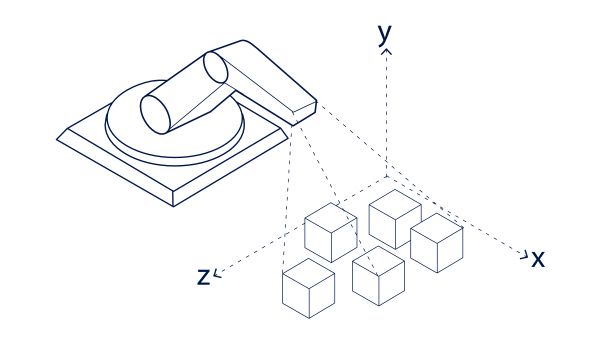Industrial cameras have been used for many years in manufacturing settings to detect dirt, defects, presence, or absence in production processes. The emerging technologies have enabled the production of industrial 3D cameras with high-precision vision, enabling view over a 360° spectrum through the collection of X, Y, and Z axes dimensions of image data.

They are able to capture more detailed information on an object, including its size, shape, and position, which is essential for handling and other operations in industrial settings. 3D machine vision cameras are among the best industrial cameras to enable automated image production and analysis.
The technology has been used widely in the manufacturing and logistics industry. This article explains some of the benefits of 3D machine vision cameras in manufacturing and logistics, their use and how to choose the right type for particular functions.
The Benefits of Using 3D Machine Vision Cameras
3D machine vision systems consist of multiple cameras that enable viewing of the target objects' environment, location, and orientation. Multiple cameras or laser displacement sensors allow the systems to perform many functions.
Systems that use laser displacement sensor technology are able to perform surface inspection functions, including measurement of distances and volumes, enabling the determination of shapes and production of 3D images even with a reduced number of cameras. 3D machine vision camera systems produce digital models of the object by laser triangulation for more accurate execution of inspection tasks.
The 3D mapping optimizes the outcomes for unexpected variables, including light, color, and even position of target objects.
Some of the uses of 3D machine vision cameras in industrial settings include optical gauging, non-contact 3-D measurements, barcode & OCR reading, and process control in manufacturing and logistics.

The functions are associated with the following benefits:
Labor-saving
Industrial process surveillance using 3D vision camera systems saves a huge percentage of manual labor time. Some industrial processes are repetitive and dull. 3D machine vision systems relieve human labor of an unsuitable working environment while allowing the employees to concentrate on other innovative activities that benefit the organization. The cameras are also smaller, saving on space which is essential in industrial settings.
Increased Efficiency
The application of 3D vision camera systems for industrial purposes increases process efficiency by reducing costs and improving the quality of products. Automating repetitive processes reduces labor costs which are essential for overall cost reduction and profit margin.
Using industrial 3D cameras supports automation of surveillance of processes such as mechanical punch press, proactively preventing defects and fault in operations, which enhances the quality of products. The increased quality of products through surveillance of other activities like optical gauging ensures that the products meet the required standards, averting instances of product recalls.
Enhanced Productivity
3D machine vision camera systems can operate for many hours compared to human labor that would be fatigued. Integration of machine vision technologies with robotics enables longer hours of operations which improves productivity, elevating the organization’s revenues. Further, the ability to produce enough parts reduces the need to outsource production, saving on extra costs and giving the organization better control of product quality.
Reduction of Wastes
Using machine vision cameras in an industrial environment enables continuous inspection of the process to ensure accuracy. For example, using the systems for inspecting fan shafts allows a quicker determination of parts that would fit in an engine with great precision.
Increased Compliance
3D machine vision systems make it easier to review processes and trace problems essential for compliance. For example, suppose a defect is realized on products. In that case, the process can be reviewed using images captured during production to ascertain the source of the problem and make accurate corrective decisions.
How to Use 3D Machine Vision Camera in Manufacturing
As seen earlier, 3D machine vision cameras have multiple uses in industrial settings. This section provides an example of how the technology is used in the pharmaceutical industry to inspect the production process and product quality based on the principle of presence and absence.
The bottle cap and level of content are monitored by machine vision as the bottle moves in the production line. When the bottle reaches close to the camera, proximity sensors detect and capture images that are relayed to the PC; there is an algorithm for classifying images as OK and NOT OK components.
The bottles classified as OK have the cap and the correct level of content. The ones that do not meet the standards are removed from the production line by the pneumatic ejector.
3D machine vision camera system can also be used for blister pack inspection for label reading, identification of half-tablets, missing tablets, broken tablets, and colors of tablets. The movement of the pack along the conveyor activates the light, and the camera that takes the image of the pack and any of the defects leads to automatic removal from the production line.
How to Choose the Right 3D Machine Vision Camera
Choosing the right camera for the right purpose is important when acquiring 3D vision cameras for the best results. Mech-Mind provides a range of cameras and information on which 3D machine vision systems are suitable for different industrial environments.
Ensuring the right camera, lens, controller, and monitor is essential for consideration for inspection purposes in different production settings. The sensor size should always match the lens image cycle for the best outcomes. Matching the lens to sensor resolution and pixel size is also vital for machine vision cameras to ensure resolution compatibility.
Lighting is another important consideration when choosing the right cameras. Evaluating the maximum aperture helps in determining the amount of supplemental lighting required. A larger maximum aperture may eliminate the need for supplemental lighting. Mech-Mind can help with the technical aspects of choosing the right machine vision system.
Summary
In conclusion, leveraging 3D machine vision systems for production has evidence for increased productivity, efficiency, improved quality of products, and traceability of defects. Making the right decision on the suitable machine vision systems is an important initial step in acquiring the technology for industrial purposes.